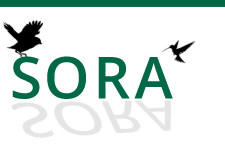Notes on Winter Bird Roosts
Online Full Text
During January and February, 1928, small flocks of from eight to twenty Lawrence Goldfinches (Spinus lawrencei) were common about my home on the outskirts of East San Diego. California. These birds were to be seen daily feeding on the seeds of the greasewood (Adenostoma fasciculatum). Some fifty or more roosted nightly in a large clump of lemonadeberry bush (Rhus integrifolia) in the center of a grassy patch in a nearby canyon. They were flushed from this bush at dusk and also at dawn on several occasions.
During the first two months of 1929 not even one Lawrence Goldfinch was seen in our neighborhood, but we had other bird visitors. Whenever I visited the canyon at dusk I saw flock after flock of Western Robins (Turdus migratorius propinquus) and Cedar Waxwings (Bombycilla cedrorum) coming from the direction of San Diego and alighting in the bushes. After some flying back and forth they settled down for the night, chiefly in the large clumps of lemonadeberry bush, laurel-leafed sumac (Rhus lautina), toyon (,em>Photinia arbutifolia) and holly-leafed cherry (Prunus ilicifolia), and in the thickets of scrub oak (Quercus dumosa). At dawn, hundreds of these birds were to be seen in the canyon until about sunrise when flock after flock would head back toward the city. These two species were common in the city during the day wherever berry-bearing shrubs or trees afforded them food. I was at a loss to understand why these birds should leave the partial safety of the city with the excellent and secluded roosting places available in Balboa Park for the low brush of this canyon where they were far more open to attack by bird and mammal predators. I found the remains of several that had been killed, and I also found two robins that must have been shot by rabbit hunters.
During this same period and about a mile from the canyon where the robins and waxwings roosted I often saw Black-crowned Night Herons (Nycticorax nycticorax naevius) at sunset winging their way over the business section of East San Diego. After watching them on several evenings I finally saw them leaving a cluster of eucalyptus trees in a yard just a block and a half from one of the most traveled streets in the city and on the very edge of the business section. Without doubt these birds spent their days in these trees from which they were seen to emerge on several subsequent evenings and then wing their way toward the open country. Aside from small ornamental pools in yards, the nearest water containing fish was at least a mile and a half distant. Three immatures seen on February 14 were the most seen at one time, but a few evenings later a beautiful adult was seen to leave its roost in a Monterey cypress not more than fifteen feet above a sidewalk in the residential section. On another occasion, an immature Night Heron was seen to alight in a yard near a little pool where Pacific tree frogs (Hyla regilla) were singing, but it was immediately frightened away by the movements of a woman working among the flowers in the same yard. In spite of the large size and conspicuous appearance of these birds and the loud “qwonks” which they frequently uttered in flight, no one except myself, so far as I could observe, noted their presence in the city.
O'Rourke Zoological Institute, Balboa Park, San Diego, California, August 15, 1989
Creative Commons License
Recommended Citation
Gander, Frank F.
(1930)
"Notes on Winter Bird Roosts,"
Condor: Vol. 32
:
Iss.
1
, Article 13.
Available at:
https://digitalcommons.usf.edu/condor/vol32/iss1/13

